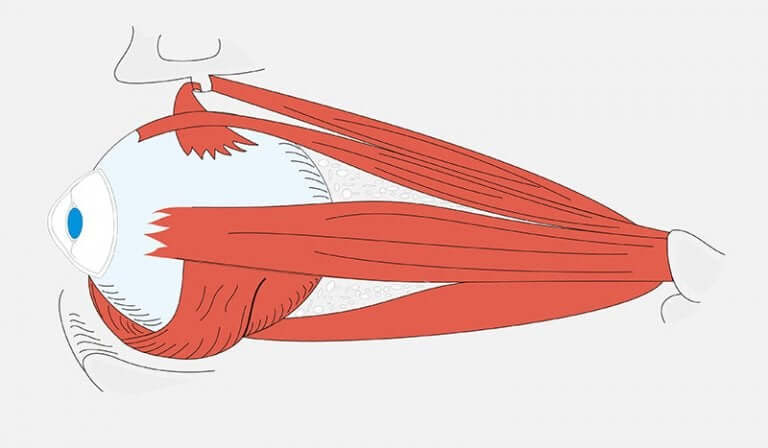Strabismus in Dogs: Causes and Treatment

Just like in humans, strabismus in dogs is an eye disorder where the eyes don’t look in the same direction at the same time. Despite being considered a defect, strabismus is actually a desired trait in certain dog and cat breeds, and even in certain human cultures.
When we speak of this being a defect, we don’t mean that it’s something that disfigures the animal. Rather, it comes from something that’s going wrong with the muscles that hold the eye in place. This can be hereditary, or can sometimes be from another physical cause, such as a tumor or an infection.
The muscles that move the eyeball
Mammals’ eyeballs have six muscles supporting them for each eye. These muscles are what make the eye move in different directions. These muscles can be classified into the following groups:
- Rectus (straight) muscles. There are four: the inferior, superior, medial and lateral rectus muscles. These muscles are attached to the sclera (the white part of the eyeball) by means of tendons. The inferior and superior rectus muscles make the eye move up and down. The medial and lateral muscles permit the eye to move from side to side.
- Oblique muscles. There are two of these: the inferior and superior oblique muscles. The combined action of these allows the eye to gyrate, either clockwise or anticlockwise.
- Retractor muscles (not counted among the 6 muscles that move the eyeball). These control the movement of the eyelids.

When these muscles are all functioning correctly, the eyes can move together at the same time and in the same direction. Strabismus is when one or more of these muscles don’t work properly.
There are various types of strabismus, depending on what direction the affected eye or eyes look towards (misalignment).
- Divergent: the eye aims towards the edge of the face.
- Convergent: the eye directs towards the nose.
- Hypertropia: the eye tends to stay looking upwards.
- Hypotropia: the eye positions its gaze with the pupil directed towards the floor.
Causes of strabismus in dogs
The causes of strabismus are many and varied. Unfortunately, there isn’t a cure for every type of strabismus that can affect dogs. This disorder in dogs is almost always considered a defect, although it can be a hereditary trait linked to certain breeds.
In which dog breeds does strabismus tend to occur most frequently? Among the most common are the Shar-Pei, Irish Wolf Hound, Akita and Pug breeds. Strabismus is often caused by the substitution of the straight medial muscle with fibrous tissue during the growth process. This later impedes correct eye movements.
Apart from inherited problems or abnormal muscle growth, there are also some diseases related to the immune system that can provoke strabismus.
For example, this is the case with immune-mediated myositis (muscle inflammation). When this occurs in the eye muscles, strabismus can result and can sometimes even cause an abnormal protrusion of the eyeball. Problems related to the thyroid gland can also cause strabismus.

Tumors are another possible cause of strabismus in dogs. A tumor occurring close to the eyeball, or even inside the eye, can put pressure on the different external eye muscles. These muscles then don’t work as they should, causing the eye to move abnormally.
Occasionally, cross-eyes can result from some trauma. There have been various cases of dogs with a fracture in the zygomatic bone (the bone that’s just below the eye that joins the cranium with the jawbone) that develop severe strabismus.
Lastly, some diseases or malfunctions related to the nervous system can also cause strabismus in dogs. For example, a disjointed union of the nerves, or a major problem such as fluid build up in the brain can contribute.
Treatment for strabismus in dogs
Treatment will always depend on what’s causing the problem. When an innate disorder or inherited condition is the cause, it may require a small operation, or simply therapy to reinforce the muscles around the eye.
On the other hand, if a disease is causing the problem, it’s likely that if you treat the disease the problem will go away on its own. If that doesn’t happen, the muscles may be damaged and may require either surgery or therapy.
All cited sources were thoroughly reviewed by our team to ensure their quality, reliability, currency, and validity. The bibliography of this article was considered reliable and of academic or scientific accuracy.
- Allgoewer, I., Blair, M., Basher, T., Davidson, M., Hamilton, H., Jandeck, C., … & Shelton, G. D. (2000). Extraocular muscle myositis and restrictive strabismus in 10 dogs. Veterinary ophthalmology, 3(1), 21-26.
- Salinas, E. M., Rosales, M. D. L. L. M., & Estrada, X. Z. (2004). Caracterización histológica y ultraestructural de meningoencefalomielitis granulomatosa en dos perros. Veterinaria México, 35(4), 307-315.
- Salvador, C. R., & Martínez, M. E. G. (2013). Anatomía Veterinaria. 8. Anatomía del ojo (globo del ojo y órganos accesorios) en las especies domésticas. REDUCA, 5(2).
- Drobatz, K, Beal, M. & Syring, R. (2015). Manual de manejo del trauma en el perro y el gato. Inter-Médica: Buenos Aires.
This text is provided for informational purposes only and does not replace consultation with a professional. If in doubt, consult your specialist.